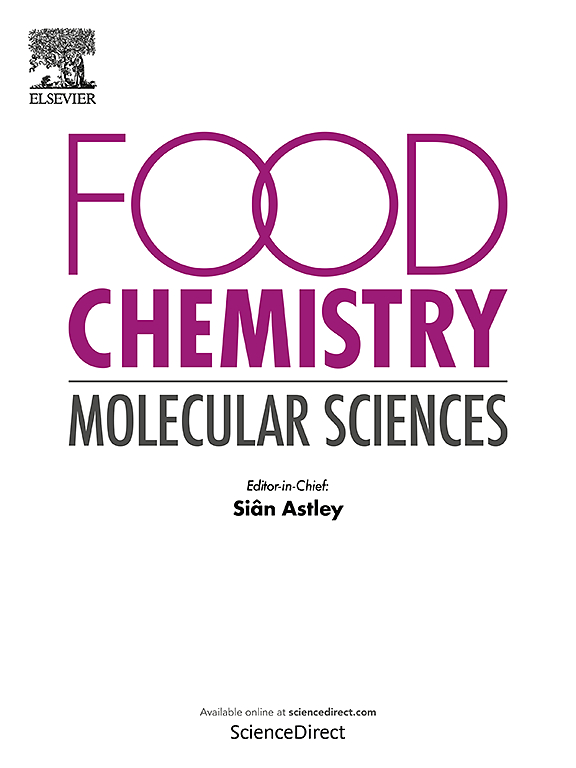温度诱导蘑菇颜色变化的分子机制及其园艺意义
IF 4.7
Q2 FOOD SCIENCE & TECHNOLOGY
引用次数: 0
摘要
帽色是Stropharia rugosoannulata蘑菇的关键商业性状,但其温度诱导变异的分子机制仍知之甚少。本研究结合代谢组学和转录组学方法,鉴定了在不同温度条件下帽色从白色向酒红色转变的关键代谢物和相关基因。代谢组学分析鉴定出1913种代谢物,其中黄酮类衍生物如槲皮素-3- o -葡萄糖苷和山奈酚类化合物在高温下优先在酒红蘑菇中积累。转录组学分析发现了13428个差异表达基因(DEGs),其中36个是类黄酮生物合成途径的结构基因。值得注意的是,在酒红蘑菇中观察到SrGene13140 (F3’h)和SrGene10248 (F3’5’h)的上调,表明它们参与了红色色素的产生。相比之下,SrGene10253 (f3’h)在黄蘑菇中的表达更高,表明其具有同种异构体特异性羟基化活性。综合基因-代谢物相关性和网络分析显示,苯丙氨酸解氨酶(PAL)、类黄酮3′-羟化酶(f3’h)和4-香豆酸辅酶A连接酶(4CL)等关键酶是与颜色相关的类黄酮生物合成的中心调控因子。这些发现为揭示温度诱导的蘑菇颜色变化的分子基础提供了有价值的见解,并为蘑菇育种和园艺提供了潜在的应用前景。本文章由计算机程序翻译,如有差异,请以英文原文为准。
Molecular mechanisms and horticultural implications of temperature-induced color variation in Stropharia rugosoannulata mushrooms
Cap color is a critical commercial trait in Stropharia rugosoannulata mushrooms, yet the molecular mechanisms underlying its temperature-induced variation remain poorly understood. This study integrated metabolomic and transcriptomic approaches to identify key metabolites and genes associated with the transition of cap color from white to wine-red under different temperature conditions. Metabolomic analysis identified 1913 metabolites, with flavonoid derivatives such as quercetin-3-O-glucoside and kaempferol-based compounds accumulating preferentially in wine-red mushrooms at high temperatures. Transcriptomic analysis revealed 13,428 differentially expressed genes (DEGs), including 36 structural genes in the flavonoid biosynthesis pathway. Notably, upregulation of SrGene13140 (F3′H) and SrGene10248 (F3′5′H) was observed in wine-red mushrooms, suggesting their involvement in red pigment production. In contrast, SrGene10253 (F3′H) was more highly expressed in yellow mushrooms, indicating isoform-specific hydroxylation activity. Integrated gene-metabolite correlation and network analysis highlighted key enzymes, including phenylalanine ammonia lyase (PAL), flavonoid 3′-hydroxylase (F3′H), and 4-coumarate: coenzyme A ligase (4CL), as central regulators of color-related flavonoid biosynthesis. These findings provide valuable insights into the molecular basis of temperature-induced color variation in S. rugosoannulata and offer potential applications in mushroom breeding and horticulture.
求助全文
通过发布文献求助,成功后即可免费获取论文全文。
去求助
来源期刊

Food Chemistry Molecular Sciences
Agricultural and Biological Sciences-Food Science
CiteScore
6.00
自引率
0.00%
发文量
83
审稿时长
82 days
期刊介绍:
Food Chemistry: Molecular Sciences is one of three companion journals to the highly respected Food Chemistry.
Food Chemistry: Molecular Sciences is an open access journal publishing research advancing the theory and practice of molecular sciences of foods.
The types of articles considered are original research articles, analytical methods, comprehensive reviews and commentaries.
Topics include:
Molecular sciences relating to major and minor components of food (nutrients and bioactives) and their physiological, sensory, flavour, and microbiological aspects; data must be sufficient to demonstrate relevance to foods and as consumed by humans
Changes in molecular composition or structure in foods occurring or induced during growth, distribution and processing (industrial or domestic) or as a result of human metabolism
Quality, safety, authenticity and traceability of foods and packaging materials
Valorisation of food waste arising from processing and exploitation of by-products
Molecular sciences of additives, contaminants including agro-chemicals, together with their metabolism, food fate and benefit: risk to human health
Novel analytical and computational (bioinformatics) methods related to foods as consumed, nutrients and bioactives, sensory, metabolic fate, and origins of foods. Articles must be concerned with new or novel methods or novel uses and must be applied to real-world samples to demonstrate robustness. Those dealing with significant improvements to existing methods or foods and commodities from different regions, and re-use of existing data will be considered, provided authors can establish sufficient originality.
 求助内容:
求助内容: 应助结果提醒方式:
应助结果提醒方式:


